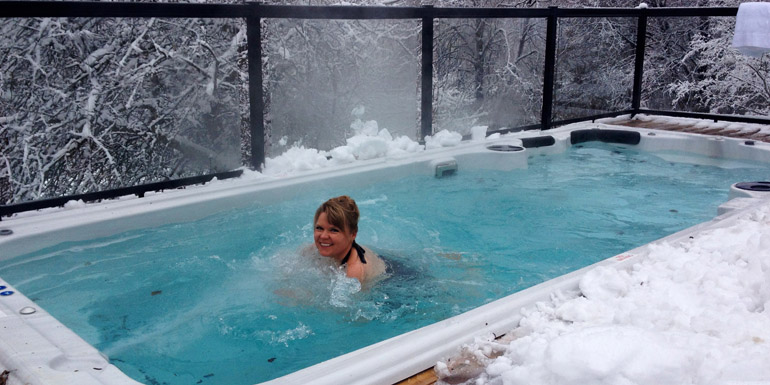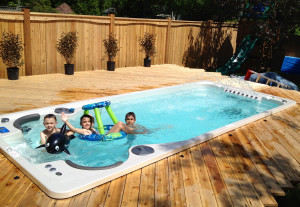
By Jennifer Gannon
For some builders who have traditionally found the installation of swimming pools to be challenging in some backyards—whether due to space or the homeowner’s budget—swim spas have opened the door to just about anyone looking for a large conventional pool. Swim spas, in a sense, are mini-versions of swimming pools, which can be installed just about anywhere, and accommodate swimming in place against a swift current. Where retailers truly benefit is the fact they can also promote the advantage of relaxation—especially after a swim or workout—in one of the jetted hydrotherapy seats these spas also offer.

Most swim spas are designed around jet pumps, which create a flat and uplifting current of water that enables continuous swimming up to 13 km/h (8 mph) without turning. The degree of resistance is also variable, which allows the swimmer to set the pace.
The idea of a low-impact exercise routine for improved cardiovascular health is a big selling feature for consumers. Further, swim spas are fun and safe for all ages and abilities; shallow enough for most children and non-swimmers, yet deep enough to satisfy the most serious swimmer, jogger, or water aerobics enthusiast.
Marketing the benefits of aquatic fitness
For customers who are all about aquatic fitness and therapy, some swim spas are designed without side benches, providing swimmers the advantage of maximum arm and legroom—essentially converting the mini-pool into a mini-gym.
In this regard, retailers should stay informed about water aerobics and aquatic training programs as numerous exercises can be performed in a swim spa. In fact, the water’s natural resistance allows people to simultaneously exercise every muscle and joint in the body. Further, the water also serves to cool the body during the routine, which is beneficial during outdoor summer workouts. Many people who like to follow an in-water fitness conditioning program would be interested in these features.
When looking at demographics, in terms of swim spa sales and aquatic fitness, water aerobics is completely inclusive—age and ability are not factors. Therefore, not only is it important to be able to explain this to customers, but also to realize the market potential for these products. For customers who are unsure, it can be easily explained; water allows the body to be buoyant, causing less strain and stress on the joints and muscles.
Besides the cardiovascular and respiratory benefits, aquatic therapy in a swim spa also helps to:
- Increase and maintain muscular flexibility;
- Improve mobility and range of motion;
- Increase muscular strength;
- Improve co-ordination, balance, and posture;
- Burn calories;
- Massage muscles;
- Provide the ability to train during very hot/cold weather;
- Supplement or provide an alternative to regular training;
- Provide a relaxing and pleasurable experience; and
- Offers the body a great alternative to traditional exercise (when the body is supported by water, the exerciser’s heart rate is slightly lower, making aquatic therapy relatively safe for obese individuals, pregnant women, and those suffering from hypertension and heart disease).
A person does not need to know how to swim to take advantage of exercising in a swim spa either. They can wear one of many devices that will enable them to stay afloat with little effort, enabling them to concentrate on their routine. The ideal location to perform water aerobics is in an indoor swimming pool. Alternatively, a heated indoor or outdoor swim spa, where the water temperature is controlled, also works well.
| Treading Water |
|---|
| Water exercise programs have been making a splash and are one of the reasons why swim spas have become popular for many households. Here are some points to share with customers when using their swim spa to perform water aerobics: • Water temperature—warm water relaxes the muscles and eases stiff joints. For an arthritis-oriented program, a water temperature of 28 to 31 C (82 to 88 F) is recommended, with an absolute minimum of 28 C (82 F). • Intensity—exercising in water is so much easier and there may be temptation to overexert. Therefore, to be safe, start off slowly. Tell customers who are new to water aerobics to respect their limitations. • Buddy system—even though the swim spa is typically 4 m (1.2 ft) deep, it is best to have another person present while working out. • Wear supportive clothes that are warm and comfortable. • Wear pool shoes to provide traction while exercising and to protect the soles of the feet from abrasion. • Take a water bottle to the swim spa. Dehydration is a real issue as bathers may not be aware they are perspiring while exercising in the water.For individuals old or young, fit or not so fit, aquatic exercise may help to manage a healthy weight, tone, and maintain bone density. Swim spa users do not need to get their hair wet, or be a swimmer. They are also extremely practical as they function as a personal water gym in the privacy of the customer’s home. |
Sell the convenience aspect
Those who own a swim spa find it easier to follow a fitness routine and, thus, make it part of their daily lives; however, there are several other features that should be discussed with customers to ensure they are purchasing the swim spa best suited to their needs. To do this, make sure customers remain happy with their purchase. It is important to make sure they have researched the product in terms of the swim experience, fun and fitness factors, comfort, design and massage, company/brand reputation, insulation, and ease of maintenance.






